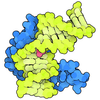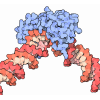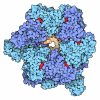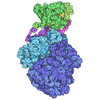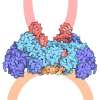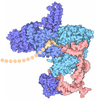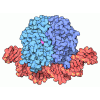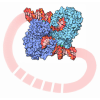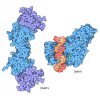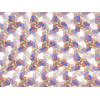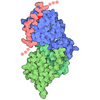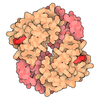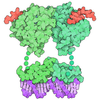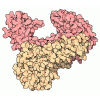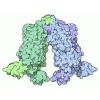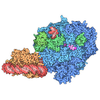[English] 日本語
 Yorodumi
Yorodumi- PDB-9rjs: Structure of the Bacteriophage PhiKZ non-virion RNA Polymerase bo... -
+ Open data
Open data
- Basic information
Basic information
| Entry | Database: PDB / ID: 9rjs | |||||||||
|---|---|---|---|---|---|---|---|---|---|---|
| Title | Structure of the Bacteriophage PhiKZ non-virion RNA Polymerase bound to an analogue of its promoter | |||||||||
 Components Components |
| |||||||||
 Keywords Keywords | RNA BINDING PROTEIN / PhiKZ / nvRNAP / RNA / DNA / transcription | |||||||||
| Function / homology | DNA / DNA (> 10) / DNA-directed RNA polymerase / PHIKZ056.1 / PHIKZ123 / PHIKZ074 / PHIKZ068 Function and homology information Function and homology information | |||||||||
| Biological species |  Phikzvirus phiKZ Phikzvirus phiKZ | |||||||||
| Method | ELECTRON MICROSCOPY / single particle reconstruction / cryo EM / Resolution: 2.59 Å | |||||||||
 Authors Authors | Chen, C. / de Martin Garrido, N. / Yakunina, M. / Aylett, C.H.S. | |||||||||
| Funding support |  United Kingdom, 2items United Kingdom, 2items
| |||||||||
 Citation Citation |  Journal: J Mol Biol / Year: 2024 Journal: J Mol Biol / Year: 2024Title: Structure of the Bacteriophage PhiKZ Non-virion RNA Polymerase Transcribing from its Promoter p119L. Authors: Natàlia de Martín Garrido / Chao-Sheng Chen / Kailash Ramlaul / Christopher H S Aylett / Maria Yakunina /   Abstract: Bacteriophage ΦKZ (PhiKZ) is the founding member of a family of giant bacterial viruses. It has potential as a therapeutic as its host, Pseudomonas aeruginosa, kills tens of thousands of people ...Bacteriophage ΦKZ (PhiKZ) is the founding member of a family of giant bacterial viruses. It has potential as a therapeutic as its host, Pseudomonas aeruginosa, kills tens of thousands of people worldwide each year. ΦKZ infection is independent of the host transcriptional apparatus; the virus forms a "nucleus", producing a proteinaceous barrier around the ΦKZ genome that excludes the host immune systems. It expresses its own non-canonical multi-subunit non-virion RNA polymerase (nvRNAP), which is imported into its "nucleus" to transcribe viral genes. The ΦKZ nvRNAP is formed by four polypeptides representing homologues of the eubacterial β/β' subunits, and a fifth that is likely to have evolved from an ancestral homologue to σ-factor. We have resolved the structure of the ΦKZ nvRNAP initiating transcription from its cognate promoter, p119L, including previously disordered regions. Our results shed light on the similarities and differences between ΦKZ nvRNAP mechanisms of transcription and those of canonical eubacterial RNAPs and the related non-canonical nvRNAP of bacteriophage AR9. | |||||||||
| History |
|
- Structure visualization
Structure visualization
| Structure viewer | Molecule:  Molmil Molmil Jmol/JSmol Jmol/JSmol |
|---|
- Downloads & links
Downloads & links
- Download
Download
| PDBx/mmCIF format |  9rjs.cif.gz 9rjs.cif.gz | 670.9 KB | Display |  PDBx/mmCIF format PDBx/mmCIF format |
|---|---|---|---|---|
| PDB format |  pdb9rjs.ent.gz pdb9rjs.ent.gz | 427.5 KB | Display |  PDB format PDB format |
| PDBx/mmJSON format |  9rjs.json.gz 9rjs.json.gz | Tree view |  PDBx/mmJSON format PDBx/mmJSON format | |
| Others |  Other downloads Other downloads |
-Validation report
| Summary document |  9rjs_validation.pdf.gz 9rjs_validation.pdf.gz | 1.3 MB | Display |  wwPDB validaton report wwPDB validaton report |
|---|---|---|---|---|
| Full document |  9rjs_full_validation.pdf.gz 9rjs_full_validation.pdf.gz | 1.3 MB | Display | |
| Data in XML |  9rjs_validation.xml.gz 9rjs_validation.xml.gz | 71.5 KB | Display | |
| Data in CIF |  9rjs_validation.cif.gz 9rjs_validation.cif.gz | 113.6 KB | Display | |
| Arichive directory |  https://data.pdbj.org/pub/pdb/validation_reports/rj/9rjs https://data.pdbj.org/pub/pdb/validation_reports/rj/9rjs ftp://data.pdbj.org/pub/pdb/validation_reports/rj/9rjs ftp://data.pdbj.org/pub/pdb/validation_reports/rj/9rjs | HTTPS FTP |
-Related structure data
| Related structure data |  54012MC 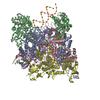 8queC C: citing same article ( M: map data used to model this data |
|---|---|
| Similar structure data | Similarity search - Function & homology  F&H Search F&H Search |
- Links
Links
- Assembly
Assembly
| Deposited unit | 
|
|---|---|
| 1 |
|
- Components
Components
-Protein , 5 types, 5 molecules ABCDE
| #1: Protein | Mass: 57976.605 Da / Num. of mol.: 1 Source method: isolated from a genetically manipulated source Source: (gene. exp.)  Phikzvirus phiKZ / Production host: Phikzvirus phiKZ / Production host:  |
|---|---|
| #2: Protein | Mass: 59442.824 Da / Num. of mol.: 1 Source method: isolated from a genetically manipulated source Details: Numbering correct in original mmCIF file / Source: (gene. exp.)  Phikzvirus phiKZ / Production host: Phikzvirus phiKZ / Production host:  |
| #3: Protein | Mass: 78780.453 Da / Num. of mol.: 1 Source method: isolated from a genetically manipulated source Source: (gene. exp.)  Phikzvirus phiKZ / Production host: Phikzvirus phiKZ / Production host:  |
| #4: Protein | Mass: 77513.461 Da / Num. of mol.: 1 Source method: isolated from a genetically manipulated source Source: (gene. exp.)  Phikzvirus phiKZ / Production host: Phikzvirus phiKZ / Production host:  |
| #5: Protein | Mass: 62959.090 Da / Num. of mol.: 1 Source method: isolated from a genetically manipulated source Source: (gene. exp.)  Phikzvirus phiKZ / Production host: Phikzvirus phiKZ / Production host:  |
-DNA chain , 2 types, 2 molecules XY
| #6: DNA chain | Mass: 23218.951 Da / Num. of mol.: 1 / Source method: obtained synthetically / Source: (synth.)  Phikzvirus phiKZ Phikzvirus phiKZ |
|---|---|
| #7: DNA chain | Mass: 22881.719 Da / Num. of mol.: 1 / Source method: obtained synthetically / Source: (synth.)  Phikzvirus phiKZ Phikzvirus phiKZ |
-Non-polymers , 1 types, 2 molecules 
| #8: Chemical |
|---|
-Details
| Has ligand of interest | N |
|---|---|
| Has protein modification | N |
-Experimental details
-Experiment
| Experiment | Method: ELECTRON MICROSCOPY |
|---|---|
| EM experiment | Aggregation state: PARTICLE / 3D reconstruction method: single particle reconstruction |
- Sample preparation
Sample preparation
| Component | Name: PhiKZ non-virion RNA polymerase bound to an analogue of promoter p119L Type: COMPLEX Details: Mismatches introduced around the transcription start site to stably open the bubble Entity ID: #1-#7 / Source: RECOMBINANT | ||||||||||||||||||||
|---|---|---|---|---|---|---|---|---|---|---|---|---|---|---|---|---|---|---|---|---|---|
| Molecular weight | Value: 0.4 MDa / Experimental value: NO | ||||||||||||||||||||
| Source (natural) | Organism:  Pseudomonas phage phiKZ (virus) Pseudomonas phage phiKZ (virus) | ||||||||||||||||||||
| Source (recombinant) | Organism:  | ||||||||||||||||||||
| Buffer solution | pH: 8 | ||||||||||||||||||||
| Buffer component |
| ||||||||||||||||||||
| Specimen | Conc.: 0.1 mg/ml / Embedding applied: NO / Shadowing applied: NO / Staining applied: NO / Vitrification applied: YES Details: PhiKZ nvRNAP complexes were mixed at 0.1 mg/mL final concentration with the P119L promoter analogue at a 1:1 ratio. Reactions were incubated for 30 min at 25 C before use. | ||||||||||||||||||||
| Specimen support | Grid material: GOLD / Grid mesh size: 300 divisions/in. / Grid type: Quantifoil R2/1 | ||||||||||||||||||||
| Vitrification | Instrument: FEI VITROBOT MARK IV / Cryogen name: ETHANE / Humidity: 100 % / Chamber temperature: 289 K Details: Settings: -4 blot force, 4 s waiting time and 0.5-1 s blotting time. |
- Electron microscopy imaging
Electron microscopy imaging
| Experimental equipment |  Model: Titan Krios / Image courtesy: FEI Company |
|---|---|
| Microscopy | Model: TFS KRIOS |
| Electron gun | Electron source:  FIELD EMISSION GUN / Accelerating voltage: 300 kV / Illumination mode: FLOOD BEAM FIELD EMISSION GUN / Accelerating voltage: 300 kV / Illumination mode: FLOOD BEAM |
| Electron lens | Mode: BRIGHT FIELD / Nominal magnification: 130000 X / Nominal defocus max: 2500 nm / Nominal defocus min: 750 nm / Cs: 2.7 mm / C2 aperture diameter: 50 µm / Alignment procedure: ZEMLIN TABLEAU |
| Specimen holder | Cryogen: NITROGEN / Specimen holder model: FEI TITAN KRIOS AUTOGRID HOLDER |
| Image recording | Electron dose: 50 e/Å2 / Film or detector model: GATAN K3 BIOQUANTUM (6k x 4k) / Num. of grids imaged: 1 / Num. of real images: 20670 / Details: Images collected as TIFF movies |
| EM imaging optics | Energyfilter name: GIF Bioquantum / Energyfilter slit width: 10 eV |
| Image scans | Sampling size: 5 µm / Width: 5760 / Height: 4092 |
- Processing
Processing
| EM software |
| ||||||||||||||||||||||||||||||||||||||||||||||||||||||
|---|---|---|---|---|---|---|---|---|---|---|---|---|---|---|---|---|---|---|---|---|---|---|---|---|---|---|---|---|---|---|---|---|---|---|---|---|---|---|---|---|---|---|---|---|---|---|---|---|---|---|---|---|---|---|---|
| CTF correction | Type: PHASE FLIPPING AND AMPLITUDE CORRECTION | ||||||||||||||||||||||||||||||||||||||||||||||||||||||
| Particle selection | Num. of particles selected: 4178816 | ||||||||||||||||||||||||||||||||||||||||||||||||||||||
| Symmetry | Point symmetry: C1 (asymmetric) | ||||||||||||||||||||||||||||||||||||||||||||||||||||||
| 3D reconstruction | Resolution: 2.59 Å / Resolution method: FSC 0.143 CUT-OFF / Num. of particles: 329400 / Algorithm: FOURIER SPACE / Num. of class averages: 1 / Symmetry type: POINT | ||||||||||||||||||||||||||||||||||||||||||||||||||||||
| Atomic model building | B value: 104.82 / Protocol: AB INITIO MODEL / Space: REAL / Target criteria: CC | ||||||||||||||||||||||||||||||||||||||||||||||||||||||
| Atomic model building | 3D fitting-ID: 1
| ||||||||||||||||||||||||||||||||||||||||||||||||||||||
| Refinement | Cross valid method: NONE Stereochemistry target values: GeoStd + Monomer Library + CDL v1.2 | ||||||||||||||||||||||||||||||||||||||||||||||||||||||
| Displacement parameters | Biso mean: 101.01 Å2 | ||||||||||||||||||||||||||||||||||||||||||||||||||||||
| Refine LS restraints |
|
 Movie
Movie Controller
Controller


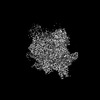
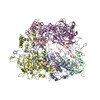

 PDBj
PDBj